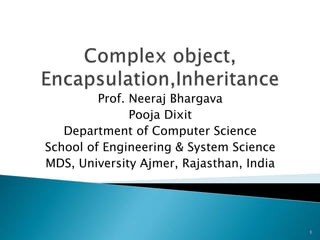
Object Constructors and Encapsulation in OOP
- 1. Prof. Neeraj Bhargava Pooja Dixit Department of Computer Science School of Engineering & System Science MDS, University Ajmer, Rajasthan, India 1
- 2. Complex objects are built from simpler ones by applying constructors to them. The simplest objects are objects such as integers, characters, byte strings of any length, Booleans and floats (one might add other atomic types). There are various complex object constructors: tuples, sets, bags, lists, and arrays are examples. The minimal set of constructors that the system should have are set, list and tuple. Sets are critical because they are a natural way of representing collections from the real world. Tuples are critical because they are a natural way of representing properties of an entity. Of course, both sets and tuples are important because they gained wide acceptance as object constructors through the relational model. Lists or arrays are important because they capture order, which occurs in the real world, and they also arise in many scientific applications, where people need matrices or time series data. 2
- 3. Encapsulation is the object model concept of including processing or behavior with the object instances defined by the class. Encapsulation allows code and data to be packaged together. Encapsulation is a basic concept for all object-oriented technologies. It was created for making a clear distinction between the specification and the implementation of an operation and in this way for enabling modularity. Encapsulation is derived from the notion of Abstract Data Type (ADT). It is motivated by the need to make a clear distinction between the specification and the implementation of an operation. It reinforces modularity and provides a form of logical data independence. 3
- 4. A superclass itself can also have a superclass. And this class in turn can have another superclass. Given this, object- oriented database systems build a hierarchy of their classes. In this example, a Student is a type of Person. Likewise, a Employee is a type of Person. Both Student and Employee inherit all the attributes and methods of Person. Student has a locally defined student ID attribute. Employee has a locally defined employee ID attribute. So, if you would look at a Student object, you would see attributes of name, date of birth, parents, children, and student ID. 4
- 5. Inheritance makes it possible to define a class as a subclass of an already existing one (superclass). The subclass inherits all attributes and methods from the superclass and can additionally define its own attributes and methods. This concept is an important mechanism for supporting reusability. Identical parts of the structure of two different classes may be defined only once in a common superclass. Is this way, less code has to be written. There are some systems that allow a class to be subclass of more than one superclass. This feature is called multiple inheritance (in contrast to single inheritance). There are certain problems that can arise due to inheritance. And these problems are even more likely to arise if multiple inheritance is used. For example, a subclass may define an attribute with the same name as an attribute already defined by a superclass. The problem gets worse when two superclasses of the same subclass define attributes and methods with the same name. Each system must come of with a mechanism to resolve this problems. 5